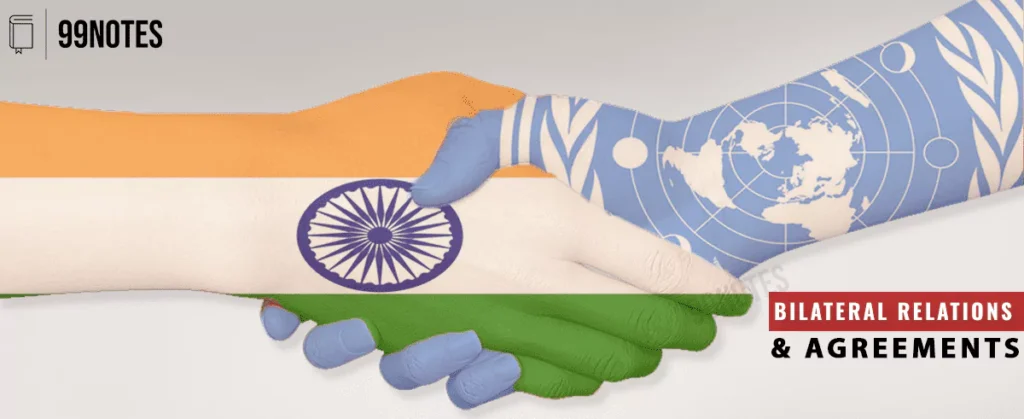
Bilateral Relations & Agreements Free UPSC Notes Download
More About Bilateral Relations & Agreements
Bilateral relations refer to the diplomatic and economic interactions between two countries. Bilateral agreements are formal agreements between two countries to cooperate on a specific issue or set of issues. These agreements can cover a wide range of topics, including trade, cultural exchange, defense, and environmental protection.
Bilateral trade agreements are perhaps the most common type of bilateral agreement. These agreements aim to reduce barriers to trade between the two countries, such as tariffs and quotas, in order to increase economic exchange and cooperation. Cultural exchange agreements, on the other hand, may focus on promoting understanding and cooperation between the two countries through activities such as student exchange programs and cultural exchanges.
Defense agreements are another common type of bilateral agreement, and may involve cooperation on military training and equipment, as well as joint military exercises. Environmental protection agreements may address issues such as climate change and conservation of natural resources.
It’s important to note that bilateral agreements are not the same as international treaties, which are agreements between multiple countries. However, bilateral agreements can sometimes serve as a stepping stone towards the development of international treaties on a particular issue.
- Bilateral relations can be complex, and may be influenced by a range of factors such as history, geography, culture, and economic interests. For example, two countries with a shared border may have a more intertwined relationship than two countries on opposite sides of the globe.
- Bilateral relations are typically managed through diplomatic channels, such as embassies and consulates. Diplomatic missions serve as a means of communication between the two countries, and may be involved in negotiating and implementing bilateral agreements.
- Bilateral agreements are often seen as a way for countries to cooperate and address shared challenges, but they can also be a source of tension if one country perceives that the agreement is not being implemented fairly. It’s not uncommon for bilateral agreements to be revised or renegotiated over time in order to address changing circumstances or to address issues that have arisen.
- In some cases, bilateral agreements may be accompanied by other forms of cooperation, such as aid programs or joint research projects. These additional forms of cooperation can help to build trust and deepen the relationship between the two countries.
India-Central Asia
The history of India’s relations with Central Asia is extensive. Over the course of two millennia, people-to-people interaction, trade, and business have fostered extensive cultural ties between the two areas.
The intimate commercial and cultural ties between the Indian subcontinent and Central Asia, whose origins may be traced to the Indus valley civilisation, diminished following India’s partition in 1947, when New Delhi lacked a clear land route to the area. This meant that goods from India destined for the Central Asian region, rather than passing through Pakistan and Afghanistan, would have to take much longer routes, typically the sea route to Iran and then the land route through Iran, thereby reducing the competitiveness of New Delhi’s exports to the region.
Despite these economic and commercial disadvantages, India’s close political connections with the Soviet Union helped maintain diplomatic links with Central Asia in the decades after its independence. India, the only non-communist nation with a diplomatic outpost in Central Asia, found itself in an advantageous position to strengthen ties with the newly independent Central Asian Republics: Kazakhstan, Kyrgyzstan, Tajikistan, Turkmenistan, and Uzbekistan, when the Soviet Union and the Cold War ended in 1991.
India and South-east and East Asia
India has a long history of cultural and economic interactions with Southeast and East Asia, and the two regions have traditionally been important trading partners. In recent years, India has sought to strengthen its economic and strategic ties with Southeast and East Asia as part of its “Act East” policy, which aims to increase India’s engagement with the region.
India has a number of bilateral trade agreements with Southeast and East Asian countries, including the ASEAN-India Free Trade Agreement and the India-Japan Comprehensive Economic Partnership Agreement. These agreements have helped to increase trade and investment between India and the region. In addition to trade, India has also cooperated with Southeast and East Asian countries on a range of other issues, such as defense, cultural exchange, and environmental protection.
India has also sought to build closer ties with Southeast and East Asian countries through regional organizations such as the Association of Southeast Asian Nations (ASEAN) and the East Asia Summit (EAS). India is a member of both organizations, and has actively participated in their meetings and activities in order to promote regional cooperation.
India and West-Asia
India has a long and complex relationship with West Asia, a region that encompasses the Middle East and the Arab world. West Asia is a strategically important region for India, as it is home to a number of key energy resources and is a major transit point for Indian trade.
India has traditionally had strong economic ties with West Asian countries, particularly in the areas of energy and trade. India is a major importer of oil and gas from the Middle East, and West Asian countries are important export markets for Indian goods. In recent years, India has also sought to expand its economic ties with the region through investment and cooperation in areas such as infrastructure and technology.
India’s relations with West Asia are not without challenges, however. The region is home to a number of ongoing conflicts and tensions, and India has had to navigate a complex geopolitical landscape in order to maintain good relations with the various countries in the region. India has also had to balance its relations with West Asian countries with its relationships with other powers, such as the United States and China, which also have significant interests in the region.
Overall, India’s relationship with West Asia is multifaceted and dynamic, and will likely continue to evolve in the coming years.
There are many and much more to know ,please click further for a detailed view.

